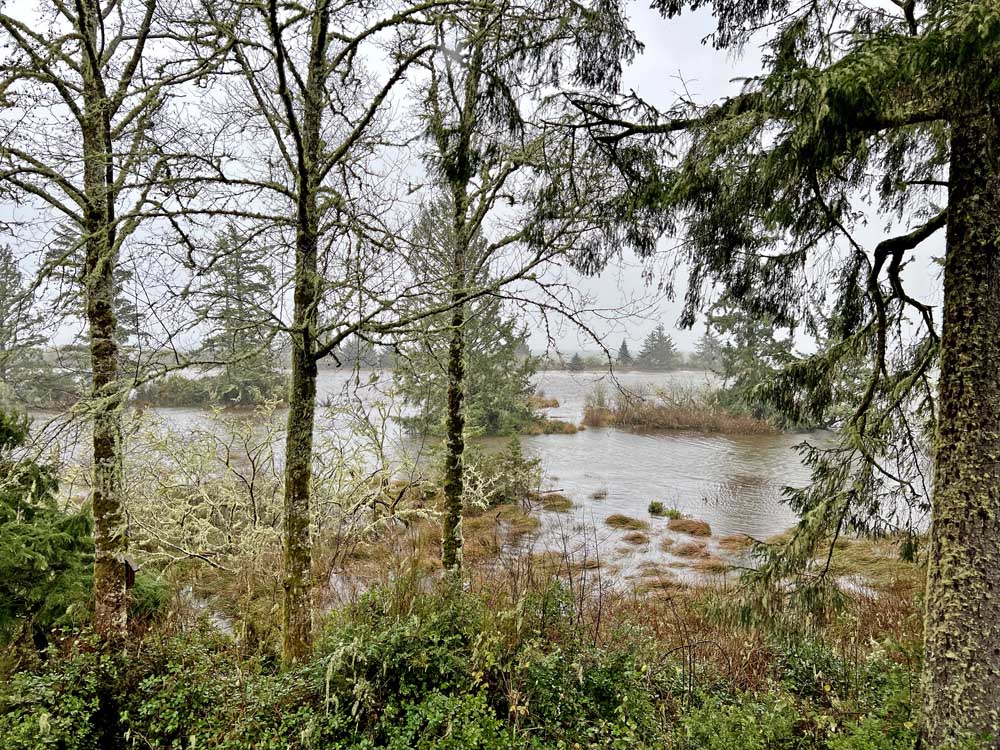Birding: ‘Water, water everywhere’ brings birds closer to see!
Published 2:28 pm Wednesday, January 12, 2022

- Forested tidal wetlands like these are prime habitat for birds and other species. This one along the western edge of Willapa Bay filled with water during recent high winter tides.
Just when I thought I had seen the best king tides ever this past December, along came Jan. 3, 2022, with its 12.8-foot tide. There was indeed water everywhere, and as of this writing there is still water, water everywhere. It was an excellent day for the raptors, ducks, shorebirds and songbirds. Nutrients stirred up by the wind on the high waters stirred up the nutrients in the wetlands creating a feast for all. The pungent odor coming from the wetlands was evidence of this phenomenon. The birds knew it and so did I.
Trending
The large flocks of ducks were mainly mallards and American wigeon, but northern pintail, green-winged teal, bufflehead, and even a few northern shovelers were observed feeding either along-side them or in a very small flock on their own. Shorebirds, such as greater-yellowlegs, black-bellied plover, killdeer, semi-palmated plovers, dunlin, and least sandpipers were in abundance during the January king tides. During those January days large concentrations of waterfowl and shorebirds were always present wherever there was water. Thousands of dunlins engaged in a feeding frenzy along the roadside edges picking for goodies in the grass and debris that had also been pushed onto lawns, and gardens by the high tides and wind. As flocks of dunlin do, at the least disturbance they flew up in unison to swirl together as one making interesting flight patterns over the water-soaked land and then, again in unison, they suddenly landed in a spot that was just to their liking. The water level is so high in some places that this scenario is still possible to see today, on Jan. 6.
Songbirds were also more prevalent during the January king tides. One hermit thrush I watched stepped gingerly on the tufts of green grass that were tall enough to peek up through water, and with each step it reached into the pungent smelling water to pick out insects and maybe a few snails and larvae. In between jabs at the surface, it would periodically stop and stand stock still. There was a bit of sun that day! Perhaps it was just taking a few moments to bask in its warmth.
A red-breasted sapsucker also seemed to take advantage of the unusually high tides. It spent its time foraging close to the base of some trees picking at the mossy spots on the bark for insects that might have been lurking there. The water was high in the wetland where it was foraging in the few trees on along its edge. Most likely, the wind pushing the tide inland caused some of the insects and other nutrients to cling to the moss on the bark. Its sap holes were close by, so it also foraged there for sap and insects that were trapped in the sap.
Trending
Raptors are more likely to find easier pickin’s on king tide days compared to other more normal tide days. Bald eagles, both adults and sub-adults, were active. The bald eagle’s relatively high-pitched voice could be heard whenever I ventured outdoors. Communication was a high priority during the kind tides. One adult perched on a fence post at the border of the Oysterville wetland. It was poised and ready to strike. A few American wigeon and a Wilson’s snipe mixed in with a large flock of mallards were excellent targets, and if snagged, would make a very tasty meal.
Several American kestrels, a peregrine falcon and several red-tailed hawks rounded out the parade of the raptors. The “kee-ee-arr” of the red-tailed hawk sparked fear among the waterfowl in the wetlands. I know it because the minute the red-tailed Hawk let out its scream up went the flock of mallards and other ducks to get out of harm’s way. Not all the resident red-tailed hawks screamed to make their presence known. Another that I watched sat quietly in a tall spruce on a branch hidden by it branches thick with green needles. It watched and sat patiently for forty-five minutes. Then, impatience set in and off it flew to find a better vantage point.
Great blue herons were not as plentiful as I expected. However, a few did fly into the wetland see what was on the menu. It must have been good because most wandered around for a long time likely foraging for amphibians in the nutrient rich water.
The king tides of January were the best yet for the study of bird behavior and identifying the species observed. Wherever I went, there was water, water, everywhere! Happy birding!









